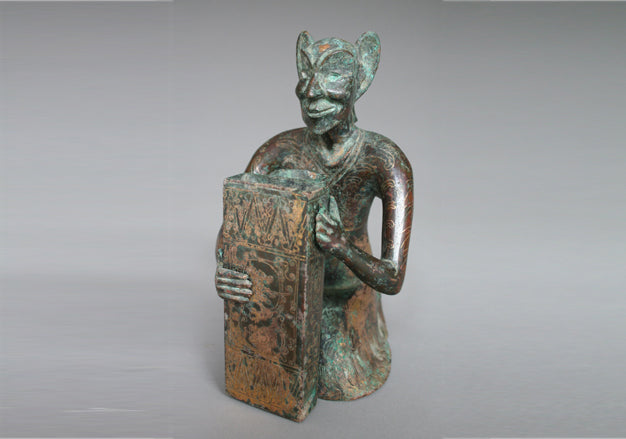
Gilded bronze feathered figure

Gilded bronze feathered man, Eastern Han Dynasty, 15.5 cm high, 9.5 cm bottom diameter, 1495 g in weight. Unearthed from C5M346 in Luoyang Locomotive Factory, Henan Province in 1987. Now in the Luoyang Museum.
In 1987, a small bronze "feathered man" statue was unearthed in a tomb of the middle and late Eastern Han Dynasty in the eastern suburbs of Luoyang (Figure 1). This bronze feathered man is gilded all over, exquisitely made, sitting in a kneeling position, holding a cylindrical vessel in front and back with both hands. The feathered man has a strange face, with big ears protruding from the top of the head, deep eyes and high nose, short beard on the lower jaw, hair draped behind the head, wearing a tight-fitting long dress with belts, wings raised behind the shoulders, legs also carved into feather wings, and delicate feather patterns, curling grass patterns and cloud patterns engraved all over the body. The cylindrical vessel held by both hands is hollow inside, with no cover on the top, and the cylindrical vessel is decorated with triangles and cloud patterns, which looks gorgeous and fantastic.
Figure 1 Side and back of the gilded bronze feathered man
The most peculiar thing about the feathered man is that in addition to the wings on his body, he also has two long ears sticking out of his head, which is similar to the image of the immortal mentioned in some literary works of the Han Dynasty. The Han Dynasty poem "Long Song" says: "The immortal rides a white deer, with short hair and long ears. He leads me to Taihua, gathers the grass and obtains the red flag. He comes to the master's door and presents a jade box of medicine. The master takes this medicine and his body becomes stronger day by day. His white hair turns black again, and his life is prolonged." The image of the immortal described in the poem is short-haired and long-eared, which is basically consistent with the image of the feathered man shown in this artifact. There is no sufficient evidence whether the cylindrical vessel held in the hand of this bronze feathered man is the medicine box mentioned in the poem. Since the cylindrical vessel is hollow and has no cover on top, it is speculated that this bronze feathered man may also be a holder for other objects.
In addition, the feathered man has a high nose and deep eyes, and has facial features different from those of the people in the Central Plains at that time. The "Huainanzi•Daoyingxun" records that the immortals seen by Lu Ao, a Taoist priest during the reign of Qin Shihuang, were "deep eyes and black temples, tears flowing down his shoulders, plump upper body and fierce lower body." In addition, after the Han Dynasty opened up the Western Regions, the people from the foreign regions were "strange-looking and good at all kinds of magic tricks and acrobatics" compared to the people in the Central Plains at that time. The appearance of this feathered man has the characteristics of an alien person, which to a certain extent reflects the contact between the Central Plains and the foreign regions, as well as the cultural exchange and integration between them.
This "feathered man" image of a combination of man and bird appeared in many archaeological discoveries in the Han Dynasty. In addition to the sculptures attached to the artifacts, there are also feathered man images in the murals, bricks and stones of the tombs of the Han Dynasty, and the funeral utensils. This is mostly related to the popular immortal ideas in the Han Dynasty. The wings raised behind the shoulders of the gilded bronze feathered man, the long hair floating behind his head, and the cloud pattern decoration on the body of the artifact make this work full of flying dynamics, which makes the viewer full of infinite reverie about the immortal world.


![8.3"China Shang Dynasty,Bronze wine cup [Fuhao Jue cup][妇好爵杯]](http://bronzc.com/cdn/shop/files/4ee0482982cfa89bb4d1cff3333a55e6_e3ca0b86-22fc-497d-9afd-578c551225a3-2.jpg?v=1733986652&width=533)

![12.8" China Ming Dynasty, Phoenix-patterned bronze vase[Ming Wanli Phoenix-patterned vase][明万历凤纹瓶]](http://bronzc.com/cdn/shop/files/4ee0482982cfa89bb4d1cff3333a55e6_a516991b-2bb9-4b2f-a2b6-4354129d006c.jpg?v=1733986953&width=533)

![14.6" China Eastern Han Dynasty Bronze vessel in the shape of a flying horse,Also known as bronze galloping horse[Horse Stepping on Flying Swallow][马踏飞燕]](http://bronzc.com/cdn/shop/files/4ee0482982cfa89bb4d1cff3333a55e6_aa3fbeb8-e08b-4a44-929a-13411ca8fb17-2.jpg?v=1733987211&width=533)

![5.9"China Tang Dynasty, Bronze of a walking dragon[Tang Walking Dragon][唐走龙]](http://bronzc.com/cdn/shop/files/2_8cb416b9-ebbd-4fe2-a905-b9277f820c16.png?v=1731488701&width=533)
